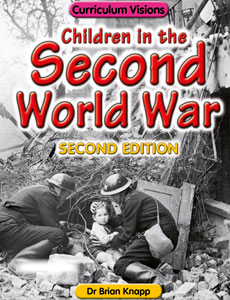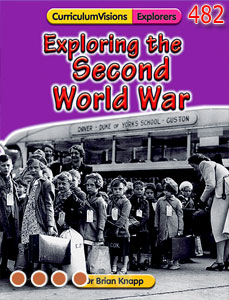War – it’s one of the most terrifying words in any language, yet it has happened in every century since records began. Many of these wars happened a long time ago and may not seem real to us.
However, the Second World War (World War II) is different. Your grandparents may have been alive during or just after this war and can still tell you of their memories.
If you look around, you may think there are few signs of the Second World War. There are memorials, of course. But is there anything else? In fact, many of the huge changes that have happened across the world in recent years were brought about by that war.
No wars start for simple reasons. Usually they start because of things that had been happening for a long time.
Some of the causes of World War II can be found in World War I, that ended 25 years earlier. At the end of that war, in 1918, Germany signed a peace treaty which the German people thought was very unfair.
For years after World War I, the Germans had little to eat, few jobs and they felt they had lost their pride and honour. This was a dangerous time because they could easily be persuaded by unscrupulous people that there was honour, glory and a better life ahead. After all, what could be worse?
This was how a small, extreme party was able to come to power. It was called the National Socialist Party, which came to be known as the Nazi Party. Its ruthless leader was Adolf Hitler.
The dark side of the Nazis was truly horrible, with Jews, gypsies and many other people being rounded up and put into concentration camps and killed. But somehow the German people did not wake up to this.
Hitler was a bold planner. He pushed and pushed against the rules of the peace treaty and the other European countries did nothing to stop him.
In Britain, the Prime Minister, Neville Chamberlain, was a very good man, but for the times he was too weak. As a result, Adolf Hitler was able to re-arm and take over other countries, while Britain – then one of the most powerful countries in the world – stood by. At the same time the United States did not want to be involved in another war and so they too stood aside.
Soon, Germany made agreements with other bad governments, such as in Italy, Russia and Japan.
Britain had agreed to protect Poland. So when Germany invaded Poland on 3 September 1939, Neville Chamberlain was forced to declare war on Germany. Because Germany was allied with countries such as Italy and eventually Japan, and because Britain had colonies across the world, this meant that this war was a World War. When the U.S. was finally forced to enter the war to defend itself, this was a truly World War.
Germany tried to isolate Britain from supplies coming from the Commonwealth and the United States.
Britain is a small country with many people. It cannot grow enough food from its own land and must get the extra food needed from overseas.
By the start of World War II, Britain was importing large amounts of wheat from the United States of America and Canada.
Other foods that were imported included cheese and butter (from Australia and New Zealand) tea (from India), coffee (from Brazil), sugar (from the West Indies) and many kinds of fruit.
Food was not the only thing that had to come from overseas. Some of these vital items were petrol (from the Middle East), wood and rubber (for car tyres, from Malaya).
One of the ways the Germans believed they could beat the British was to stop these vital supplies from arriving in Britain.
As a result they sent out their battleships and submarine fleet (U-boats) to hunt down and destroy the ships carrying supplies to Britain across the Atlantic.
So food and other essentials had to be rationed in Britain.
To help make use of all of the land, the government launched a campaign called Dig for Victory. The idea was to grow the food you (and perhaps your neighbours) needed in your garden or in your local park. London’s royal parks, golf courses and tennis courts were all dug up. Soon nearly a million and a half families were growing vegetables.
Britain held out against Germany because it had a strong navy and a skillful airforce. Soon Germany had conquered much of mainland Europe and Britain stood mostly alone. The Germans could not cross the English Channel while the airforce was in control. So in the west it was a stalemate in which Britain was slowly losing because it could not get supplies. It was using up all of its money. What was it to do?
Then two remarkable things happened. The Germans suddenly turned east to attack Russia. The Russians had been Germany's ally. Now they were fighting. It was a stupid thing to do, but it took the pressure off Britain for a while. In the United States there was enormous sympathy for Britain, but it was difficult to help without taking sides, and the U.S. did not want to take sides. But in the Pacific Japan had already overrun China and it was clearly a threat. Japan then signed a treaty of support with Germany and Italy (they were then called the Axis powers). Against all of the advice of the Japanese navy, and by sidelining the Japanese emperor, the Japanese army then set out to force the country to go to war with the United States. In particular they saw the United States bases in Hawaii as a like a knife to their throat. In this they were totally wrong. But they decided to attack Hawaii and attempt to sink the Pacific fleet of the United States. Without any warning, they bombed Hawaii on Dec 7, 1941. They had begun a war they could never win. America was now in the war.
Because Japan and Germany had a treaty, when Japan went to war with America, it automatically put Germany at war with America. America now found itself attacked from both sides, with Japan in the east and the U-boats of Germany in the west.
But with the U.S. on the side of Britain, just as it had been in the First World War, the scales were tipped so that it would be impossible for Germany to win. All the same it took four long years to defeat Germany in Europe, and even longer to defeat Japan. To save millions of U.S. lives, the United States was left with no alternative but to drop atomic bombs on the Japanese cities of Hiroshima and Nagasaki on the 6th of August and the 9th of August. This was to demonstrate to the Japanese people that they would be wiped out if they did not surrender. Japan surrendered on 15th of August 1945. Thus ended the war in Asia, and the final destruction of the Axis bloc.
Over 73 million people had died in these dreadful years.






